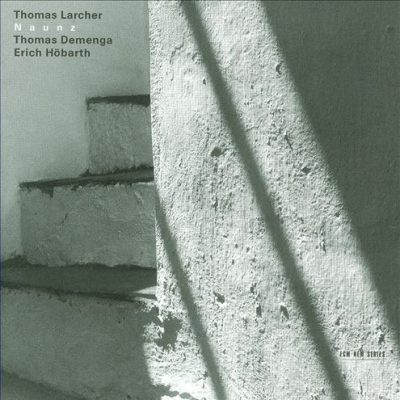Thomas Larcher: Naunz
Thomas Larcher: Naunz, Vier Seiten, Noodivihik, Klavierstück, Kraken, Antennen-Requiem für H.
Erich Höbarth (violin), Thomas Demenga (cello), Thomas Larcher (piano)
© ECM 2001
Works
Naunz for piano (1989)
Vier Seiten for violoncello (1998)
Noodivihik for piano (1992)
intro
critic acid
leave your baggage unattended
Klavierstück 1986
Kraken for violin, violoncello and piano (1994–97)
I. schnell
II. langsam
III. bewegt
IV. fließend
V. schnell
Antennen-Requiem für H. (1999)
I.
II.
III.
Austrian pianist Thomas Larcher, previously known to ECM New Series aficionados as a tactful interpreter of contemporary music, with Naunz shows his colors as a composer of the same. That Larcher is a close associate of Heinz Holliger, another musician-composer of immense talent, should come as no surprise: both compose as if through a microscope. Yet while Holliger tends to languish in protracted gazes at what lies beneath his cover slides, Larcher is more interested in compressions and calms before storms—in the message of the medium. The laser-precise title piece, written 1989 for piano, evokes a particular brain chemistry and cellular dysfunction…yet also a fractured, spatial sort of harmony. Its thirteen-and-a-half-minute duration holds a broad technical spectrum on the tongue: metallurgical hammerings, bright pops, and bluesy accents trade places in carousel fashion. Every note drips like a love-sworn face, open-mouthed, a scabbard without a sword.
Thomas Demenga pushes these images deeper into the fire in Vier Seiten (1998), throwing himself into jaggedly brushed scenery. Larcher’s trust in Demenga is obvious, for even the most challenging passages flow effortlessly at the cellist’s virtuosic touch. Ley lines crack in a symphony of such intimate proportions that the piece stabilizes, settling into meditative fog curls, a muscle torn to infinity. Further bowings are put on hold for the duration of two more piano pieces. The fractured yet resonant Noodivihik (1992) works at an even more cellular level. With scientific attention, Larcher expounds its polyphony in monosyllables while moments of clarity rub up against those of murky discomfort. Not every piece, however, is so overtly disjointed, for in such a piece as Klavierstück 1986 (the collection’s earliest composition) there is overt color-bleeding, punctuated by moments of insistence that fade into bodiless reflections.
The autobiographically inflected Kraken (1994-1997), a fascinating trio, revives Demenga and adds the violin of Erich Höbarth. In the latter’s playing is an Ysaÿe-like exuberance told yet in a language Larcher’s own, distinct for its obsessions. The entrance of piano after Höbarth’s pliant introduction lends a morose, titanic feeling of sunkenness. Violin lines evoke ghostly strangers from the wreckage, cleaving water and sky in kind. As a unit the trio forms a methodical braid, ponytail of a slumbering warrior. Larcher brings a percussive sound to his part, treading water in a marriage of staccato and legato impulses. The Holliger connection deepens as Demenga and Höbarth embark on a journey eerily reminiscent of his Duo for Violin and Cello before fragility and gnarled woodwork bring closure. Also bringing closure is the concluding Antennen-Requiem für H. (1999), an elusive piano piece that flirts with audibility by way of various extended techniques. Hands on the strings turn the instrument into a fast-forwarded film. It is a diegesis, an awakening, a genetic table setting loosed from its horizontal plane.
Larcher’s music is the equivalent of a postmortem. With a meticulousness that can only come out of self-discipline, he scours every body for clues of its demise. In so doing, he creates new life. Every helix begins a story.
quoted in : www.ecmrecords.com
Naunz: Reviews
